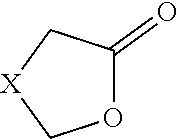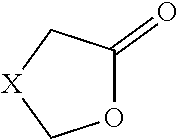Enzymatic method
a technology of enzymatic method and amination, which is applied in the field of enzymatic method, can solve the problems of inability to further modify at the -position, for example in the form of amination, and achieve the effects of reducing time, increasing yield, and high conversion rate of method
- Summary
- Abstract
- Description
- Claims
- Application Information
AI Technical Summary
Benefits of technology
Problems solved by technology
Method used
Image
Examples
example 1
Esterases for Ring Opening of ε-Caprolactone in the Presence of Methanol
[0085]Methanol (100 μl, 10% v / v) was added to buffer (870 μl, 100 mM Na2KPO4, pH 8.5), together with enzyme (6 mg, rehydrated for 20 min in 30 μl buffer).
[0086]The reaction was started by adding 6 μl (50 μM) of ε-caprolactone. After one hour the reaction was stopped by extraction with 600 μl of ethyl acetate. After phase separation, the aqueous phase was again extracted with 600 μl of ethyl acetate and the two collected organic phases were then combined, dried with Na2SO4 and analysed by GC-MS.
[0087]As enzyme, the commercial preparations
[0088]Bacillus subtilis “Esterase 008-SD” from Codexis, (NP_388425.1) and
[0089]“horse liver esterase” were used.
[0090]In all cases, a conversion to 6-hydroxyhexanoic acid methyl ester was observed.
[0091]The “horse liver esterase” used is a mixture of two isoenymes XP_003364701.1 and
[0092]XP_005608328.1 (predicted horse liver esterase), cf. in this context Comp. Biochem. Physiol. ...
example 2
Combination of Esterase with Alcohol Dehydrogenase and Transaminase
[0093]L-alanine (250 mM) and NH4Cl (150 mM) were charged in Eppendorf tubes (2 ml). The pH was adjusted to 8.5 using 6 M NaOH aq. NAD+ (0.5 mg, 0.6 μmol, in 50 μl of H2O), the transaminase ω-factor PLP (0.1 mg, 0.4 μmol, in 50 μl of H2O) and methanol (100 μl, 10% v / v) were added together with 300 μl of H2O.
[0094]Thereafter, the respective enzymes were added in accordance with the table hereinafter. For the ADHs (E2), in the case of ADH-hT (P42328.1) 100 μl of purified enzyme (0.4 U) were added, alternatively, the 6-hydroxyhexanoate dehydrogenase (chnD) from Arthrobacter sp. BP2 (AY123972.1) was used. Of the transaminase (E3), in the case of transaminase, 20 mg of lyophilised cells were added. The two transaminases used are transaminase from Ralstonia eutropha (RalEu) (YP_917746.1) and transaminase from Paracoccus denitrificans (TA_ParDen) (YP917746.1). Of the esterase (E1) from Bacillus subtilis (008) (NP_388425.1) a...
example 3
Effect of Methanol Concentration and Temperature
[0097]Alanine (250 mM) was charged in an Eppendorf Tube (2 ml). Buffer was added (Na2HPO4 / KH2PO4 300 mM, pH 8.0, 300 μl). NH4Cl was added (50 μl, 267.1 mg dissolved in 1.25 ml of H2O and supplemented with 20 μl of 6 M NaOH aq). NAD+ (0.3 mg, dissolved in 50 μl of buffer) and PLP (0.05 mg dissolved in 50 μl of buffer; 1 mg / ml of stock solution) were added. The mixtures were shaken up to homogeneous solution at 37° C., 120 rpm, for approximately 10 min.
[0098]The effect of the ω-solvent methanol was studied on the conversion of ε-caprolactone to 6-aminohexanoic acid. Of the transaminase (TA_ParDen), 20 mg of lyophilised cells were rehydrated for 15 min. Of the ADH-hT, 100 μl, equivalent to an activity of 0.4 U on the substrate 6-hydroxyhexanoic acid were used. Of the AlaDH from Bacillus subtilis (NP_388425.1), 10 μl having an activity of 0.22 U for alanine as substrate were used. Of the esterase PLE03, 2 mg, equivalent to an activity of 0...
PUM
| Property | Measurement | Unit |
|---|---|---|
| temperature | aaaaa | aaaaa |
| temperature | aaaaa | aaaaa |
| temperature | aaaaa | aaaaa |
Abstract
Description
Claims
Application Information
 Login to View More
Login to View More - R&D
- Intellectual Property
- Life Sciences
- Materials
- Tech Scout
- Unparalleled Data Quality
- Higher Quality Content
- 60% Fewer Hallucinations
Browse by: Latest US Patents, China's latest patents, Technical Efficacy Thesaurus, Application Domain, Technology Topic, Popular Technical Reports.
© 2025 PatSnap. All rights reserved.Legal|Privacy policy|Modern Slavery Act Transparency Statement|Sitemap|About US| Contact US: help@patsnap.com



